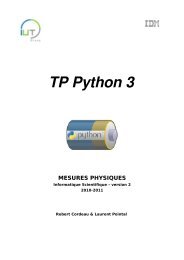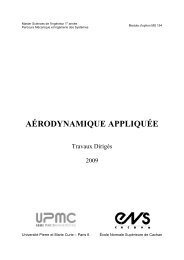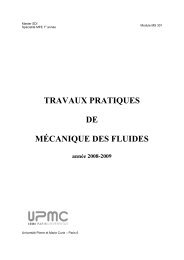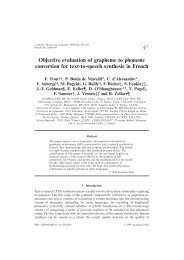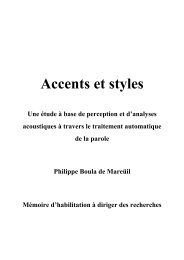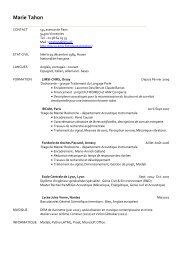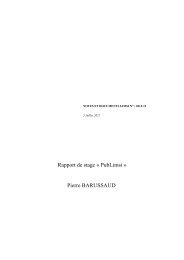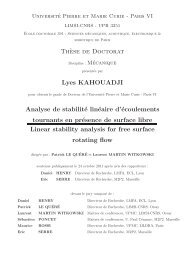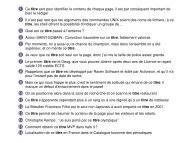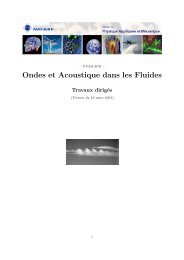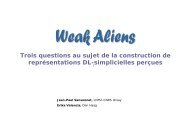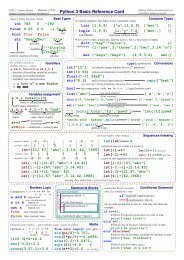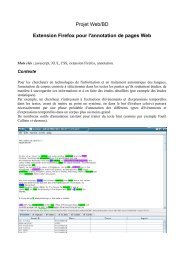Du sens des couleurs dans le Petit Robert - limsi
Du sens des couleurs dans le Petit Robert - limsi
Du sens des couleurs dans le Petit Robert - limsi
Create successful ePaper yourself
Turn your PDF publications into a flip-book with our unique Google optimized e-Paper software.
J-P. Sansonnet<br />
<strong>Du</strong> <strong>sens</strong> <strong>des</strong> <strong>cou<strong>le</strong>urs</strong><br />
<strong>dans</strong> <strong>le</strong> <strong>Petit</strong> <strong>Robert</strong><br />
Jean-Paul Sansonnet<br />
LIMSI-CNRS jps@<strong>limsi</strong>.fr<br />
Groupe AMI<br />
1
J-P. Sansonnet<br />
Objectifs<br />
• Lister tous <strong>le</strong>s <strong>sens</strong> associés par <strong>le</strong> <strong>Petit</strong> <strong>Robert</strong> aux <strong>le</strong>mmes en français <strong>des</strong><br />
principa<strong>le</strong>s <strong>cou<strong>le</strong>urs</strong> :<br />
{blanc, noir, rouge, vert, b<strong>le</strong>u, jaune, orange, marron, rose}<br />
• Mettre en rapport <strong>le</strong>s <strong>sens</strong> listés ainsi que la forme de <strong>le</strong>ur listage avec la base<br />
Wordnet (pour vert et rouge) ;<br />
• Mettre en rapport <strong>le</strong>s <strong>sens</strong> listés ainsi que la forme de <strong>le</strong>ur listage avec <strong>des</strong><br />
classifications (non <strong>le</strong>mmatiques) considérées comme ‘exotiques’ :<br />
– Classification <strong>des</strong> animaux <strong>dans</strong> <strong>le</strong>s encyclopédies chinoises du Moyen-Âge<br />
(Classification apocryphe de J. Borgès) ;<br />
– Classification <strong>des</strong> noms chez certains aborigènes d’Australie (langue Dyirbal).<br />
• En conclure que<br />
– Le <strong>Petit</strong> <strong>Robert</strong> présente une organisation <strong>des</strong> <strong>cou<strong>le</strong>urs</strong> inconsistante pour ne pas dire<br />
‘exotique’ ;<br />
– L’idée d’une classification/ontologie universel<strong>le</strong> (en termes de couverture et<br />
d’application) <strong>des</strong> <strong>sens</strong> d’un <strong>le</strong>mme (même pour un domaine aussi simp<strong>le</strong> et primal que<br />
<strong>le</strong>s <strong>cou<strong>le</strong>urs</strong>) semb<strong>le</strong> utopique ;<br />
– Les promoteurs du ‘<strong>sens</strong> par domaine’ (Rastier) voire du <strong>sens</strong> lié à l’intention<br />
communicatoire (pragmatisme) sont renforcés.<br />
2
J-P. Sansonnet<br />
Les 9 <strong>cou<strong>le</strong>urs</strong> choisies<br />
Noir et Blanc<br />
3 <strong>cou<strong>le</strong>urs</strong><br />
primaires<br />
4 <strong>cou<strong>le</strong>urs</strong><br />
secondaires<br />
fréquentes<br />
Blanc<br />
Noir<br />
Rouge<br />
Vert<br />
B<strong>le</strong>u<br />
Jaune<br />
Orange<br />
Marron<br />
Rose<br />
3
J-P. Sansonnet<br />
Blanc<br />
• ADJECTIF<br />
I.<br />
1) Qui est de la cou<strong>le</strong>ur de la neige, du lait, …<br />
2) Qui est d’une cou<strong>le</strong>ur pa<strong>le</strong> proche du blanc<br />
3) Qui n’est pas écrit « page blanche »<br />
4) Qui n’est pas souillé physiquement ou mora<strong>le</strong>ment « je suis blanc de ce crime »<br />
5) Qui n’a pas tous <strong>le</strong>s effets habituels « bal<strong>le</strong> à blanc », « voix blanche »<br />
6) Qui fait la synthèse de toutes <strong>le</strong>s fréquences « bruit blanc »<br />
II. Race blanche : « touche pas à la femme blanche »<br />
• NOM<br />
I.<br />
1) La cou<strong>le</strong>ur blanche<br />
2) Matière colorante « blanc de chaux »<br />
3) En blanc : avec la cou<strong>le</strong>ur blanche « <strong>le</strong>s hommes en blanc »<br />
II.<br />
1) Partie blanche de certaines choses : « <strong>le</strong> blanc d’oeuf » � « un blanc » = un caractère d’espace,<br />
« laisser une ligne en blanc » ; « de but en blanc »<br />
2) Nom de diverses choses caractérisées par la cou<strong>le</strong>ur blanche : maladie = « <strong>le</strong> blanc de la vigne » ;<br />
«vin blanc»<br />
• UNE BLANCHE<br />
1) Note de musique<br />
2) Bou<strong>le</strong> blanche (billard)<br />
• ABSENT<br />
– Vin : « on reprendra bien un petit blanc »<br />
4
J-P. Sansonnet<br />
Noir<br />
• ADJECTIF<br />
A. concret<br />
1) Se dit de la surface d’un corps qui ne réfléchit aucune radiation visib<strong>le</strong> « corps noir » ; figuré<br />
« c’est sa bête noire »<br />
2) Qui est de cou<strong>le</strong>ur foncée<br />
3) Qui appartient à la race mélano-africaine<br />
4) Qui est plus sombre <strong>dans</strong> son genre « du pain noir » ; « lunettes noires »<br />
5) Qui pouvant être blanc est sali « gueu<strong>le</strong>s noires »<br />
6) Qui est privé de lumière « chambre noire »<br />
7 Ancien médical : « bi<strong>le</strong> noire »<br />
8) Populaire : ivre<br />
B. Abstrait<br />
1) Assombri par la mélancolie « idées noires »<br />
2) Marqué par <strong>le</strong> Mal « colère noire »<br />
3) Dissimulé « marché noir » ; « travail au noir »<br />
• NOM<br />
1) La cou<strong>le</strong>ur noire<br />
2) L’obscurité, la nuit « enfant qui a peur du noir »<br />
3) Matière colorante « du noir animal » � figuré « broyer du noir »<br />
4) Concept symbo<strong>le</strong> de la mélancolie « il voit tout en noir »<br />
5) Partie noire d’une chose � nom de maladies <strong>des</strong> plantes « <strong>le</strong> noir de la vigne »<br />
6) Homme ou femme de race noire<br />
• (UNE) NOIRE<br />
1) Note de musique « une blanche vaut deux noires »<br />
2) Femme de race noire<br />
5
J-P. Sansonnet<br />
Rouge<br />
• ADJECTIF<br />
1) Qui est de la cou<strong>le</strong>ur du sang, <strong>des</strong> coquelicots, …<br />
2) Qui a pour emblème <strong>le</strong> drapeau rouge � SUBSTANTIF : un rouge (un communiste)<br />
• NOM<br />
3) Qui est porté à l’incan<strong>des</strong>cence<br />
4) Qui devient rouge par l’afflux du sang « voir rouge »<br />
1) La cou<strong>le</strong>ur rouge<br />
2) Colorant/pigment rouge « mon rouge (à lèvres) »<br />
3) Cou<strong>le</strong>ur du métal incan<strong>des</strong>cent<br />
4) Teinte rose ou rouge que prend la peau<br />
• ABSENT<br />
– Un peau rouge ~ tirant vers <strong>le</strong> rouge<br />
– <strong>Du</strong> rouge = vin rouge<br />
6
Les Synsets du mot « red » <strong>dans</strong> Wordnet<br />
WNsee["red"]<br />
1 300362449 adj-sat<br />
having any of numerous bright or strong colors reminiscent of the color of blood or cherries or tomatoes or<br />
rubies<br />
SYN: {chromatic,colored}<br />
1 103879230 noun<br />
ISA: {chromatic_color, chromatic_colour, spectral_color, spectral_colour}<br />
EX: {chrome_red, Turkey_red,alizarine_red, cardinal,carmine, crimson,ruby, deep_red,dark_red,<br />
purplish_red}<br />
the quality or state of the chromatic color resembling the hue of blood<br />
2 300372041 adj-sat<br />
(used of hair or fur) of a reddish brown color; "red deer"; reddish hair"<br />
SYN: {colored, coloured, in_color{p}, colorful}<br />
3 300244959 adj-sat<br />
characterized by vio<strong>le</strong>nce or bloodshed; "writes of crimson deeds and barbaric days"- Andrea Parke;<br />
"fann''d by Conquest''s crimson wing"- Thomas Gray; "convulsed with red rage"- Hudson Strode<br />
SYN: {bloody}<br />
3 107118379 noun<br />
ISA: {communist, commie}<br />
emotionally charged terms used to refer to extreme radicals<br />
4 300369643 adj-sat<br />
(especially of the face) reddened or suffused with or as if with blood from emotion or exertion; "crimson<br />
with fury"; "turned red from exertion"; "with puffy reddened eyes"; "red-faced and vio<strong>le</strong>nt"; "flushed (or<br />
crimson) with embarrassment"<br />
SYN: {colored, coloured, in_color{p}, colorful}<br />
5 300245706 adj-sat<br />
red with or characterized by blood; "waving our red weapons o''er our heads"- Shakespeare; …<br />
SYN: {bloody}<br />
6 300373564 adjective<br />
(of wine) deep reddish in color; "a red wine such as a claret or burgundy"; "a pinot noir is a red burgundy"<br />
ANT: {white}<br />
J-P. Sansonnet<br />
WNsee[w_, n_:10]<br />
n est <strong>le</strong> nombre max d'éléments affichés<br />
Affiche un mot w sous la forme:<br />
n°<strong>sens</strong> n° synsset,<br />
catégorie_<strong>le</strong>xica<strong>le</strong>,<br />
ISA:{...hyperonymes},<br />
EX: {...holonymes}<br />
<strong>le</strong> glossaire suivant est utilisé<br />
pour <strong>le</strong>s relations <strong>dans</strong> <strong>le</strong> réseau :<br />
SYN : liste <strong>des</strong> synonymes<br />
ANT : liste <strong>des</strong> antonymes-contraires<br />
ATTR : liste <strong>des</strong> attributs<br />
MEMB : liste <strong>des</strong> méronymes de<br />
membres<br />
SUBS : liste <strong>des</strong> méronymes de<br />
substance<br />
PART : liste <strong>des</strong> méronymes de parties<br />
CAUSE : liste <strong>des</strong> causes<br />
CONSQ : liste <strong>des</strong> conséquences<br />
FRAME : liste <strong>des</strong> patterns du verbe<br />
7
• ADJECTIF<br />
1) Qui est de la cou<strong>le</strong>ur de 0,53 µ<br />
J-P. Sansonnet<br />
2) Qui n’est pas mûr<br />
3) Qui a de la vigueur<br />
4) Qui est grossier « la langue verte » (vieilli)<br />
Vert<br />
5) Lié à la nature « l’Europe verte » ; « se mettre au vert »<br />
• SUBSTANTIF<br />
1) La cou<strong>le</strong>ur verte<br />
2) Lié à la verdure « mettre un cheval au vert »<br />
• ABSENT<br />
– Les verts = Club de foot de St Etienne ; <strong>le</strong> parti écologique<br />
8
Les Synsets du mot « green » <strong>dans</strong> Wordnet<br />
WNsee["green"]<br />
1 300360195 adj-sat<br />
similar to the color of fresh grass<br />
SYN: {chromatic, colored}<br />
1 200363796 verb<br />
ISA: {discolor,discolour,colour}<br />
turn or become green; "The trees are greening"<br />
FRAME: {Something -s}<br />
1 103882559 noun<br />
ISA: {chromatic_color, chromatic_colour, spectral_color, spectral_colour}<br />
EX: {greenishness, sea_green,sage_green, bott<strong>le</strong>_green, chrome_green,<br />
emerald, olive_green, yellow_green, yellowish_green,<br />
chartreuse,Paris_green, pea_green, bluish_green, teal, jade_green, jade}<br />
the property of being green; resembling the color of growing grass<br />
2 301433231 adj-sat<br />
not seasoned; "green wood"; "green pelts"<br />
SYN: {unseasoned}<br />
2 106347803 noun<br />
ISA: {tract,piece_of_land,piece_of_ground,parcel_of_land,parcel}<br />
EX: {amusement_park, funfair, p<strong>le</strong>asure_ground, village_green,<br />
Central_Park}<br />
a piece of open land for recreational use in an urban area; "they went for a<br />
walk in the park"<br />
PART: {urban_area}<br />
J-P. Sansonnet<br />
3 300890185 adj-sat<br />
lacking training or experience; "the new men were eager to fight"; "raw<br />
recruits"; "he shipped as a green hand on a vessel"<br />
SYN: {inexperienced}<br />
4 301431944 adjective<br />
not fully developed or mature; "unripe fruit"; "fried green tomatoes"<br />
SYN: {unaged}<br />
ANT: {ripe, mature}<br />
4 106325195 noun ISA: {site, land_site}<br />
an area of closely cropped grass surrounding the ho<strong>le</strong> on a golf course<br />
PART: {golf_course, golf_links, links}<br />
5 302162641 adj-sat<br />
easily deceived; "at that early age she had been gullib<strong>le</strong> and in love"<br />
SYN: {naive, naif}<br />
5 105748390 noun<br />
ISA: {vegetab<strong>le</strong>, veggie}<br />
EX: {chop-suey_greens, sprout,beet_green, chard, Swiss_chard,<br />
spinach_beet, <strong>le</strong>af_beet, salad_green, salad_greens, dandelion_green,<br />
lamb|s-quarter, pigweed, wild_spinach, wild_spinach, turnip_greens,<br />
sorrel, common_sorrel, French_sorrel,spinach}<br />
any of various <strong>le</strong>afy plants or their <strong>le</strong>aves and stems eaten as vegetab<strong>le</strong>s<br />
9
J-P. Sansonnet<br />
B<strong>le</strong>u<br />
• ADJECTIF<br />
1) Qui est de la cou<strong>le</strong>ur d’un ciel sans nuage (à 12h ?)<br />
2) Cou<strong>le</strong>ur de la peau après une contusion ou lié au froid<br />
• NOM<br />
1) La cou<strong>le</strong>ur b<strong>le</strong>ue<br />
2) Jeune recrue (en anglais green) – En 1840, <strong>le</strong>s soldats débutants portaient souvent une blouse b<strong>le</strong>u<br />
3) Une ecchymose<br />
4) Vin rouge de mauvaise qualité<br />
5) Cuisine au b<strong>le</strong>u (pas cuit)<br />
6) B<strong>le</strong>u de Méthylène<br />
7) <strong>Petit</strong> b<strong>le</strong>u = télégramme (vieilli)<br />
8) Combinaison de travail « en b<strong>le</strong>u de chauffe »<br />
• ABSENT<br />
– Un b<strong>le</strong>u = un fromage ; un plan (blueprint)<br />
– Une peur b<strong>le</strong>ue ~idées noires<br />
– Les b<strong>le</strong>us = Équipe de foot française<br />
10
• ADJECTIF<br />
J-P. Sansonnet<br />
Jaune<br />
1) Qui est de la cou<strong>le</strong>ur de l’or, du miel, <strong>des</strong> citrons, …<br />
2) Fièvre jaune (maladie)<br />
3) Race jaune<br />
4) Syndicats jaunes (anti grèves)<br />
5) Nain jaune (jeu)<br />
• NOM<br />
1) La cou<strong>le</strong>ur Jaune<br />
2) Pigment/colorant jaune<br />
3) Être habillé de jaune « <strong>le</strong> jaune ne lui va pas »<br />
4) Partie jaune d’un objet « du jaune d’œuf »<br />
5) Individu de race jaune<br />
6) Membre d’un syndicat jaune<br />
• ADVERBE<br />
2) Rire jaune<br />
11
J-P. Sansonnet<br />
Orange<br />
• NOM<br />
1) Fruit comestib<strong>le</strong> de l’oranger – pourquoi comestib<strong>le</strong>?<br />
2) Qui est de la cou<strong>le</strong>ur semblab<strong>le</strong> à cel<strong>le</strong> de l’orange<br />
• ORANGÉ<br />
1) Qui est de la cou<strong>le</strong>ur semblab<strong>le</strong> à cel<strong>le</strong> de l’orange<br />
• ABSENT<br />
– ADJECTIF : « un pull orange »<br />
12
• NOM<br />
I.<br />
J-P. Sansonnet<br />
Marron<br />
1) Fruit du châtaigner cultivé - pourquoi cultivé ?<br />
2) Marron d’inde<br />
3) Qui est de la cou<strong>le</strong>ur semblab<strong>le</strong> à cel<strong>le</strong> <strong>des</strong> marrons<br />
II. Jeton de présence <strong>des</strong> ouvriers - 1752<br />
III. Populaire<br />
1) Coup de poing<br />
2) Être trompé « je suis marron encore une fois »<br />
• ADJECTIF<br />
1) Ancien esclave – 1640 Antil<strong>le</strong>s<br />
2) Qui se livre à l’exercice illégal/clan<strong>des</strong>tin d’une profession « avocat marron »<br />
13
J-P. Sansonnet<br />
Rose<br />
• NOM<br />
A.<br />
1) F<strong>le</strong>ur du rosier<br />
� romantique : «roman àl’eau de rose»; «la bibliothèque rose»<br />
� frais : « comme une rose » ; « ne pas sentir la rose »<br />
2) Nom de f<strong>le</strong>urs qui ne sont pas <strong>des</strong> roses ! «rose trémière»; «laurier rose»<br />
B. Par analogie de forme<br />
1) Rosace<br />
2) Rose <strong>des</strong> vents<br />
3) Diamant en rose<br />
4) Rose de sab<strong>le</strong>s<br />
• ADJECTIF<br />
1) Qui est d’un rouge très pa<strong>le</strong> comme la rose<br />
� optimiste : « voir la vie en rose » ; pessimiste : « ce n’est pas rose »<br />
2) La cou<strong>le</strong>ur rose « un vieux rose »<br />
• (UNE) ROSEUR<br />
1) Tache de cou<strong>le</strong>ur rouge pa<strong>le</strong> sur la figure<br />
• (UN) ROSÉ<br />
1) Vin<br />
• ABSENT<br />
– Champignon : « j’ai trouve que <strong>des</strong> rosés »<br />
14
La classification chinoise de J. L. Borgès<br />
Dans la préface de son essai “Les mots et <strong>le</strong>s<br />
Choses” (Nrf Gallimard 1966), Michel Foucault<br />
fait état d'un texte de J. L. Borges <strong>dans</strong> ses<br />
“Enquêtes” (Folio Gallimard 1974), dont la<br />
<strong>le</strong>cture dit-il “ébran<strong>le</strong> <strong>le</strong>s surfaces ordonnées et<br />
tous <strong>le</strong>s plans qui assagissent pour nous <strong>le</strong><br />
foisonnement <strong>des</strong> êtres, faisant vacil<strong>le</strong>r et<br />
inquiétant pour longtemps notre pratique<br />
millénaire du Même et de l'Autre” ce qui veut<br />
dire qu'il est à la fois rigolo et profond. Ce texte<br />
cite “une certaine encyclopédie chinoise” où il<br />
serait écrit que :<br />
Les animaux se divisent en<br />
a) appartenant à l'Empereur, b) embaumés, c)<br />
apprivoisés, d) cochons de lait), e) sirènes, f)<br />
fabu<strong>le</strong>ux, g) chiens en liberté, h) inclus <strong>dans</strong><br />
cette classification, i) qui s'agitent comme <strong>des</strong><br />
fous, j) innombrab<strong>le</strong>s, k) <strong>des</strong>sinés avec un<br />
pinceau très fin en poil de chameau, l) etc., m)<br />
qui viennent de casser la cruche, n) qui de loin<br />
ressemb<strong>le</strong>nt à <strong>des</strong> mouches.<br />
J-P. Sansonnet<br />
15
Les classifieurs du Dyirbal<br />
Also known as Djirbal, an Australian language of northern Queensland, in the rainforests south of Cairns,<br />
remarkab<strong>le</strong> in several respects. Sadly the language is in severe decline, though not yet extinct: around a<br />
hundred speakers remained in 1982, divided among several dia<strong>le</strong>cts.<br />
– First it contains a sublanguage used when one's mother-in-law is present, cal<strong>le</strong>d an avoidance<br />
language or mother-in-law language. The normal form of the language is cal<strong>le</strong>d Guwal and the<br />
mother-in-law language is cal<strong>le</strong>d Dyalnguy. There are fewer words in Dyalnguy; they are more<br />
generic: the grammar is the same.<br />
– Second it exhibits the rare phenomenon of syntactic ergativity. The <strong>des</strong>cription of it by the linguist<br />
Bob Dixon is an important work in linguistics, often quoted, because of the light it throws on<br />
ergativity, and syntax generally. Dyirbal is agglutinative, using suffixes but not prefixes, and has<br />
fairly free word order. Younger speakers, under the influence of English, are neg<strong>le</strong>cting the ergative<br />
case.<br />
– Third, it has four noun classes. This is common enough in languages - German and Russian and<br />
Greek have three, Spanish and Italian two, Bantu languages many - but the distribution of nouns<br />
across the categories prompted the linguist George Lakoff to entit<strong>le</strong> a book “Women, Fire, and<br />
Dangerous Things”. (In French the moon is feminine and the sun is masculine: these lists don't<br />
really reveal much about the French or Dyirbal mind.)<br />
Here are the four classes listed by their artic<strong>le</strong>:<br />
– Bayi: men, kangaroos, possums, bats, most snakes, most fishes, some birds, most insects, the<br />
moon, storms, rainbows, boomerangs, some spears, etc.<br />
– Balan: women, anything connected with water or fire, bandicoots, dogs, platypus, echidna, some<br />
snakes, some fishes, most birds, fireflies, scorpions, crickets, the stars, shields, some spears, some<br />
trees, etc.<br />
– Balam: all edib<strong>le</strong> fruit and the plants that bear them, tubers, ferns, honey, cigarettes, wine, cake.<br />
– Bala: parts of the body, meat, bees, wind, yamsticks, some spears, most trees, grass, mud, stones,<br />
noises, language, etc.<br />
J-P. Sansonnet<br />
Sources :<br />
1) Everything2.com « Dyirbal Bayi »<br />
2) G. K<strong>le</strong>iber, « La sémantique du prototype » p163 citant G.<br />
Lakoff 1986-1987 qui cite W. Dixon 1982 & A. Schmidt 1983<br />
16
Domaines sémantiques<br />
J-P. Sansonnet<br />
Vocabulaire partagé <strong>des</strong> vins<br />
Blanc : vin blanc<br />
Noir : pinot<br />
B<strong>le</strong>u : vin de mauvaise qualité (P. <strong>Robert</strong>)<br />
Rouge : vin rouge<br />
Vert : vin pas mûr<br />
Jaune : vin jaune<br />
Rosé : vin rosé<br />
objets actions lieux<br />
barrique cueillir vignob<strong>le</strong><br />
bouteil<strong>le</strong><br />
Espace : Vin<br />
presser<br />
cave<br />
bouchon déguster château<br />
Vocabulaire partagé de la politique<br />
Blanc : vote blanc<br />
Noir : ∈ minorité défavorisée<br />
B<strong>le</strong>u : -<br />
Rouge : communiste<br />
Vert : écologiste<br />
Jaune : anti-gréviste<br />
Rose : -<br />
objets actions lieux<br />
urne voter mairie<br />
bul<strong>le</strong>tin<br />
Espace : politique<br />
débattre<br />
sénat<br />
loi élire commune<br />
Vocabulaire spécifique <strong>des</strong> vins Vocabulaire spécifique de la politique<br />
17
J-P. Sansonnet<br />
Concepts and categories<br />
Author<br />
E. Pritchard, University of Winnipeg<br />
• The following connects with material in chapter 7 of Hunt & Ellis, where we are discussing how information in LTM is organized. The<br />
following are ideas about how conceptual information (declarative memory) is stored and used. Recently, the emphasis has gone from how<br />
conceptual information is stored to how peop<strong>le</strong> process that information. This switch has happened with the rise of exemplar theories,<br />
categorization experiments, and similarity judgments. But that's getting ahead.<br />
• Concepts are essentially each litt<strong>le</strong> idea that we have in our heads. This inclu<strong>des</strong> not only every thing, but every attribute of every thing.<br />
So, we have a concept of a square, and we have concepts of corners, si<strong>des</strong>, and equality, which are the attributes (or features) of being<br />
square. Similarly, we have a concept of a penguin, and we have concepts of birds, black, white, feathers, swimming, and Antarctica.<br />
The Classical view of concepts<br />
• Jerome Bruner was one of the first to study concepts and concept <strong>le</strong>arning. Bruner's task was more of a prob<strong>le</strong>m solving task than an<br />
examination of peop<strong>le</strong>'s use of concepts. Peop<strong>le</strong> would try to figure out what concept Bruner had se<strong>le</strong>cted by picking cards, and receiving<br />
feedback as to whether the card they se<strong>le</strong>cted was an examp<strong>le</strong> of the concept or not.<br />
• Bruner's work resulted in the classical view of concepts. According to the classical view, concepts have defining features. Thus, whether any<br />
particular instance is a concept or not is c<strong>le</strong>ar. Members of a category can be neatly specified. Intuitively, the classical view makes <strong>sens</strong>e.<br />
• But what about chairs? Must we be ab<strong>le</strong> to sit on them? Must they have 4 <strong>le</strong>gs? (bean bag chair) How are chairs different from stools?<br />
(three <strong>le</strong>gged chairs) What about furniture? Rugs? Marb<strong>le</strong> floor? Te<strong>le</strong>phone?<br />
• Even naturally occuring plants and animals can be difficult to categorize (the oft mentioned debate about whether a tomato is a vegtab<strong>le</strong> or<br />
a fruit). All of these categorizing difficulties <strong>le</strong>d to the downfall of the classical view.<br />
Probabilistic View of Concepts<br />
• As Bruner's work <strong>le</strong>d to the classical view of concepts, Wittgenstein's work <strong>le</strong>d to the probabilistic view of concepts. Wittgenstein introduced<br />
the notion of family resemblance, which suggests that category members tend to share some characteristic properties or attributes or<br />
features, but there are no defining features.<br />
• The best examp<strong>le</strong> of the category is cal<strong>le</strong>d the prototype. But prototypes are not context <strong>sens</strong>itive, so a cello is a typical musical instrument<br />
in the context of a concert hall, but an atypical instrument in the context of camp fires. Peop<strong>le</strong>'s expectations of a prototype can change<br />
from one situation to another. The probabilistic view implies three things.<br />
• One, there will be a difference between category members in the number of characteristic properties each member has.<br />
• Two, category boundaries will be fuzzy, so it will not be c<strong>le</strong>ar whether some instances are category members or not.<br />
• Three, category <strong>le</strong>arning is not a simp<strong>le</strong> matter of figuring out the defining features of a concept/category, because there may not be any<br />
such features.<br />
Source : Web<br />
http://io.uwinnipeg.ca/~epritch1/amnotesfall2000.html<br />
Page : « Concepts - Lecture Notes - E_ Pritchard.htm »<br />
18
J-P. Sansonnet<br />
The prototype theory<br />
• Rosch and Mervis demonstrated that the more category properties a concept had the higher it was rated as typical of that category. The<br />
number of characteristic properties correlates with typicality ratings.<br />
• Rosch suggested that how peop<strong>le</strong> used concepts was related to their cognitive economy and perceived world structure. Cognitive economy<br />
is the idea of having enough categories, but not too many. The ideal cognitive economy of concepts is rarely, if ever, attained.<br />
• Perceived world structure relates the idea that some attributes tend to be combined with other attributes (or features). In Bruner's cards,<br />
you will notice that attributes are uncorrelated. That is, if an object is black says nothing about how many objects are on the card. The lack<br />
of correlation between attributes is unnatural, as some attributes tend to occur together in the real world. For examp<strong>le</strong>, wings and feathers<br />
tend to occur together (birds), although not always (bats and aeroplanes)<br />
Vertical and Horizontal Dimensions<br />
• Rosch also introduced the ideas of vertical and horizontal dimensions to categories. The vertical dimension refers to how inclusive the<br />
category is, or how much stuff is beneth it in a conceptual hierarchy.<br />
• With this dimension, Rosch also suggested that there was a basic <strong>le</strong>vel of concepts, and at that <strong>le</strong>vel concepts share more features or<br />
attributes than at higher <strong>le</strong>vels. It is the natural <strong>le</strong>vel for naming objects. Interestingly, children seem to acquire basic <strong>le</strong>vel concepts before<br />
other concepts. Examp<strong>le</strong>s of basic <strong>le</strong>vel concepts are bird, cat, dog, car, boat, pen, pencil.<br />
• Curiously, cross-cultural studies of biological categorization identify the genus <strong>le</strong>vel as the basic <strong>le</strong>vel. At the genus <strong>le</strong>vel are map<strong>le</strong> tree, oak<br />
tree, robin, eag<strong>le</strong>, etc. Notice that this is the subordinate <strong>le</strong>vel, according to Rosch. Why the difference? Perhaps there was a difference in<br />
the <strong>le</strong>vel of biological expertise between the subjects in the cross-cultural studies and Rosch's subjects, who were undergraduates. Also,<br />
the tasks were somewhat different. In the cross-cultural studies, naming tasks were used, but Rosch used perceptual tasks and feature<br />
listing to examine concept know<strong>le</strong>dge.<br />
• The horizontal dimension refers to how similar or different concepts are at the same vertical <strong>le</strong>vel. This is where prototypicality comes in, as<br />
some concepts share more of the characteristic features of that concept than other concepts. Sharing more features will mean that the<br />
concepts are closer together along the horizontal dimension. More prototypical concepts will share more attributes with each other than<br />
with non-prototypical concepts.<br />
Prob<strong>le</strong>ms with Prototypes including Linear Separability<br />
• Prototype models of concepts assume that some information about individual concepts is forgotten or ignored. The prototype is the best<br />
examp<strong>le</strong> of the concept, or perhaps the average concept examp<strong>le</strong>, and individual differences are not represented in the prototype.<br />
However, prototype representations do not include several bits of information, includingcategory size, the variability of category members,<br />
and an account for correlation between attributes of the category members.<br />
• But there is evidence that peop<strong>le</strong> will use such information to make categorization decisions. There is also the idea of linear separability.<br />
Linear separability suggests that category members can be separated from non-category members along some dimension(s) based on the<br />
number of characteristic features the members have. Here's a graph of this idea.<br />
• Prototype models suggest that linear separability should make it easier to <strong>le</strong>arn a category, because examp<strong>le</strong>s of the category will be closer<br />
that categories prototype than some other prototype. However, categories that are linearly separab<strong>le</strong> are not easier to <strong>le</strong>arn than categories<br />
that are not linearly separab<strong>le</strong>. Thus, linear separability is not an important factor in category <strong>le</strong>arning, which implies that the prototype<br />
view of concepts and categories is incomp<strong>le</strong>te.<br />
Source : Web<br />
http://io.uwinnipeg.ca/~epritch1/amnotesfall2000.html<br />
Page : « Concepts - Lecture Notes - E_ Pritchard.htm »<br />
19
J-P. Sansonnet<br />
Exemplar theories<br />
• If not prototypes, then what? Another variation on the probabilistic view involves the use of examplars. Examplar models suggest that concepts are <strong>le</strong>arned by storing<br />
exemplars of that concept, which have more information than a prototype. The additional information that exemplars have can be helpful when making categorization<br />
decisions.<br />
• New information is categorized as an examp<strong>le</strong> of that concept, or not, based on similarity to the exemplars already known. A new experience activates the exemplars in<br />
memory. Not a sing<strong>le</strong> exemplar, but many, which may each be used in considering how to categorize the new experience.<br />
• Exemplar views can account for information that prototypes do not, such as<br />
– category size,<br />
– the variability of category members, and<br />
– correlations between the attributes of category members.<br />
Similarity<br />
• Exemplar views suggest that new information is judged based on its similarity to stored exemplars. But can similarity explain categorization? No. In fact, similarity is not very<br />
well understood. Similarity judgments are very context <strong>sens</strong>itive. Someone from Quebec City and someone from Winnipeg may seem very dissimilar in Ottawa, but they may<br />
seem very similar in Calcutta.<br />
• Also, the features considered in similarity judgments are quite limited. Based on what features are considered can result in concepts being judged as very similar or very<br />
dissimilar. For examp<strong>le</strong>, plums and lawn mowers have lots of features in common: they weigh <strong>le</strong>ss than 1000 kg; they are droppab<strong>le</strong>; they don't hear very well; they are both<br />
products of planet earth; they cannot be worn by penguins; and on and on. Given so many commonalities, why don't we say that plums and lawn mowers are very similar?<br />
Theories of how the world works<br />
• Perhaps we don't judge plums and lawn mowers to be similar, because we have theories of the world. That is, we may constuct concepts and categories that help us explain<br />
the world. Though plums and lawn mowers have many features in common, so they may seem very similar, we have different theories about their place in this world, so we<br />
do not put plums and lawn mowers in the same category (usually).<br />
• I say usually, because there may be some situations where we do want to put plums and lawn mowers in the same category. This relates to Larry Barsalou's work on ad hoc<br />
categories. Ad hoc categories are created for the first time at a moment's notice. Things to take out of your house, when it's on fire, is one examp<strong>le</strong> of an ad hoc category.<br />
• Interestingly, ad hoc categories also have a graded structure, which indicates that peop<strong>le</strong> (within a particular culture) think about familiar objects in the same way. Barsalou<br />
suggests ad hoc categories have an implicit goal. The graded structure results from the degree to which an object helps to attain that implicit goal.<br />
How concepts are created: Lakoff<br />
• The exemplar view explains quite a bit of data for how peop<strong>le</strong> make categorizations, but it doesn't explain how categories are initially formed. George Lakoff, a linguist, has<br />
been very interested in the issue of how peop<strong>le</strong> create categories and concepts. He has examined the issue of categorization in different languages.<br />
• In Dyirbal, an Australian aboriginal language, there are four categories: bayi, balan, balam, and bala. Everything that exists can be put into these four categories. As you<br />
might expect, if a peop<strong>le</strong> have only four categories for things, then some things could put together that we might not perceive to belong together. Specifically, women, fire,<br />
and dangerous things are all in the same category (balan).<br />
• Lakoff explains how categorization in Dyirbal, or any other language, could have happened using three princip<strong>le</strong>s.<br />
– Domain of experience princip<strong>le</strong>, so things that are experienced in the same way are categorized together.<br />
– Myth and belief princip<strong>le</strong>, things that are linked by myth or belief are categorized together.<br />
– Important property princip<strong>le</strong>, things that have an important property are categorized together.<br />
• In Dyirbal, bayi and balan are categories for human ma<strong>le</strong> and human fema<strong>le</strong>, balam is for non-human living things, and bala is for everything else. Women are placed in the<br />
balan category (domain of experience princip<strong>le</strong>), and women are believed to be related to the sun (myth and belief princip<strong>le</strong>), which is related to fire, so fire is also placed in<br />
the balan category, but an important property of fire is that it's dangerous (important property princip<strong>le</strong>), so dangerous things are also placed in the balan category.<br />
Source : Web<br />
http://io.uwinnipeg.ca/~epritch1/amnotesfall2000.html<br />
Page : « Concepts - Lecture Notes - E_ Pritchard.htm »<br />
20
J-P. Sansonnet<br />
Conclusion<br />
• Il apparaît deux faits<br />
– Dans <strong>le</strong>s 9 <strong>le</strong>mmes étudiés, <strong>le</strong> traits sémantique de cou<strong>le</strong>ur-percept-visuel /rouge/,<br />
/vert/ … existe (même si non cité <strong>dans</strong> <strong>le</strong> PR) comme nom et comme adjectif, donnant<br />
un noyau sémantique commun à tous <strong>le</strong>s <strong>le</strong>mmes de cou<strong>le</strong>ur ;<br />
– Par contre, <strong>le</strong>s traits autres <strong>sens</strong> sont très dispersés et semb<strong>le</strong>nt liés à <strong>des</strong> emplois<br />
métaphoriques.<br />
• On peut en déduire (pour <strong>le</strong>s <strong>cou<strong>le</strong>urs</strong>)<br />
– L’existence d’un <strong>sens</strong> générique (probab<strong>le</strong>ment génésique/génétique) ;<br />
– L’application/mapping (par analogie, par métonymie,…) de ce <strong>sens</strong> pour<br />
étiquetter/discriminer <strong>des</strong> sous-catégories <strong>dans</strong> un domaine donné :<br />
• Marquer/discriminer <strong>le</strong>s vins par <strong>des</strong> <strong>cou<strong>le</strong>urs</strong><br />
• Marquer/discriminer <strong>le</strong>s équipes de sport par <strong>des</strong> <strong>cou<strong>le</strong>urs</strong><br />
• Marquer/discriminer <strong>le</strong>s factions politiques par <strong>des</strong> <strong>cou<strong>le</strong>urs</strong><br />
• Moralité<br />
– Avec Yarowsky, il convient de constater l’adage « One <strong>sens</strong>e per discourse » qui stipu<strong>le</strong><br />
que <strong>dans</strong> un contexte linguitique donné il est extrêmement rare qu’un <strong>le</strong>mme soit<br />
employé avec deux <strong>sens</strong> différents (<strong>dans</strong> la même phrase « ? Le rouge était noir » =<br />
« <strong>le</strong> communiste était ivre », <strong>dans</strong> <strong>le</strong> même paragraphe, texte, …) ;<br />
– Donc, en pratique, il faudrait recenser <strong>le</strong>s <strong>sens</strong> non par <strong>le</strong>mmes mais par domaines<br />
(vision statique) ou par situation (vision dynamique liée à l’intention <strong>dans</strong> l’action).<br />
21



